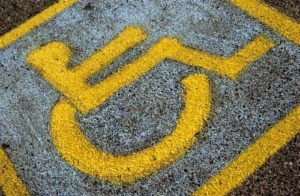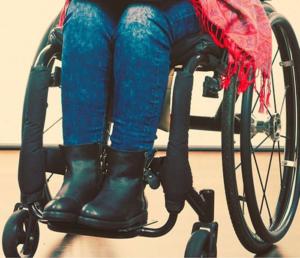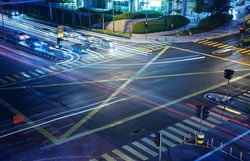 Auto v. Wheelchairs: Why Are They More Vulnerable to Crashes?
Auto v. Wheelchairs: Why Are They More Vulnerable to Crashes?
Motorized Wheelchairs are Faster Crossing Roadways, Difficult to See
Getting around outdoors in a wheelchair has its challenges. Especially at busy intersections.
Certainly all pedestrians are at great risk of injury or even death when they step into the roadway, but if you are a person using a wheelchair a recent study shows you are 36 percent more likely to die crossing the road than someone who is not.
There are certainly many factors that contribute to this higher risk including visibility, whether it’s a wheelchair or motorized scooter, was the person in a crosswalk or mid-block, the design of the roadway and crosswalks, the motorist’s actions and even timed traffic lights that changed too quickly.
“Oftentimes, people who use wheelchairs are forced to cross roadways that are not designed for people with disabilities and are generally not pedestrian-friendly at all,” said Attorney James Johnson, a California personal injury lawyer. “Unfortunately, some cities or counties fail to provide safe crossings for their residents — let alone providing a safe crossing for disabled people.”
 Researchers at Georgetown University Analyzed Accident Records from 2006 to 2012
Researchers at Georgetown University Analyzed Accident Records from 2006 to 2012
A study conducted by a team of Georgetown University researchers found that between 2006 and 2012 there were 528 wheelchair users who died in traffic collisions across the United States and that data reveals these victims were at a higher risk of being killed than other pedestrians in the general population.
Indeed, John Kraemer, an epidemiologist and lawyer at Georgetown, is the study’s lead author. His worked together with his colleague, Connor Brenton, who gathered news reports and police records between 2006 and 2012 across the U.S for roughly 250 traffic fatalities involving pedestrian in wheelchairs and also used data compiled by the Centers for Disease Control (CDC). One of the obstacles to the study was that police reports do not always mention whether or not a person was using a wheelchair.
The study was published by BMJ Open.
Kraemer also used federal data that showed two fatalities for every 100,000 pedestrian wheelchair users per year compared to the mortality rate for the general population which was 1.5 deaths per 100,000 people, according to data analyzed from the National Highway Traffic Safety Administration’s Fatality Analysis Reporting System (FARS).
Among the findings, researchers found that one in five collisions involved a driver who failed to yield to the right-of-way to the pedestrian. Additionally, roughly half of all crashes in the study took place at an intersection and 40 percent of those crashes involved a location that did not have traffic-control devices such as pedestrian signals or countdown clocks.
Additionally, the study showed that men who use wheelchairs are five times more likely to die in a traffic accident than a woman who uses one. Among men who were 50 to 64 years old, there was a 75 percent higher risk than men in the same age group that were not in wheelchairs.
Motorists, Wheelchairs and Visibility
 One of the main reasons for the higher mortality rate is that more than 75 percent of fatal wheelchair crashes reported that the driver failed to take evasive measures to avoid the crash such as steering or braking, the report said. It’s highly likely that the drivers in these cases did not see the person in the wheelchair.
One of the main reasons for the higher mortality rate is that more than 75 percent of fatal wheelchair crashes reported that the driver failed to take evasive measures to avoid the crash such as steering or braking, the report said. It’s highly likely that the drivers in these cases did not see the person in the wheelchair.
Indeed, a person in a wheelchair, much like a small child, is lower to the ground. About 21 percent of drivers also failed to yield the right-of-way to pedestrians in wheelchairs and the researchers noted that motorized wheelchairs may move so fast that they go undetected by a motorist until it is too late.
Crosswalk or No Crosswalk
Roughly 47 percent of fatal collisions reported in the study involved wheelchair users who were in a crosswalk, but 18 percent were using an intersection without a marked crosswalk. It’s always best to use marked crosswalks at intersections whether you are in a wheelchair or you are a pedestrian or bicyclist. Too often risks are taken and the result can be a tragedy.
Another obstacle facing people who use wheelchairs is that whether it’s a small two-lane street or larger highway, urban planners often forget to design roadways with disabled people in mind.
Some progress has been made over the years due to requirements by the American Disability Act that requires cut curbs and ramps in some locations, but there is still problems with timed pedestrian countdowns not providing enough time for pedestrian crossings and lighting at night is also a concern at many pedestrian crossings.
To make roads safe for everyone, urban planners must also consider those using wheelchairs, as well as pedestrians who are blind or deaf or have other impairments.
The California car accident lawyers at Johnson Attorneys Group represents victims of traffic accidents, personal injury, slip and fall and nursing home abuse. Call today at 855-703-4186 to request a free consultation.
- Hesperia Crash Bear Valley Road and Second Avenue - April 26, 2024
- 6 Injured Victorville Crash US Highway 395, Eucalyptus Street - April 26, 2024
- Patricia Lopez Killed in Crash on McHenry Avenue in Del Rio - April 26, 2024


